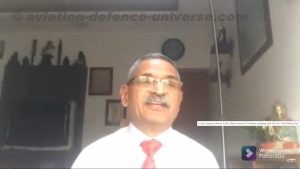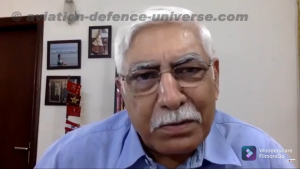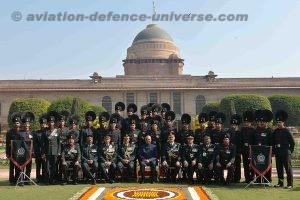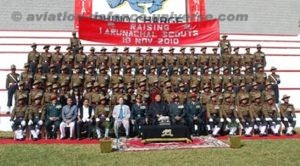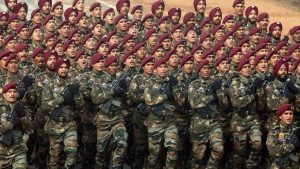
New Delhi. “Men apart every man an emperor”, Shatrujeet (The Conqueror) — the motto of some of the toughest men and best soldiers of the Indian Army , who carry out the most difficult operations with josh, élan and success. The Parachute Regiment of the Indian Army is is made up of men who are bravest of the brave..
The Parachute Regiment is an airborne and special forces regiment of the Indian Army. It was raised in 1945 as part of the British Indian Army but was disbanded after the World War II and was re-raised in 1952 as part of the Indian Army. Currently it comprises seven Special Forces, six airborne, two Territorial Army and one Rashtriya Rifles battalions.
On 15 April 1952, the Parachute Regiment was re-raised by absorbing the three existing parachute battalions of the 50th Parachute Brigade. The 1st battalion, Punjab Regiment (Para) was redesignated as the 1st battalion, Parachute Regiment (Punjab). The 3rd battalion, Maratha Light Infantry (Para) was redesignated as the 2nd battalion, Parachute Regiment (Maratha). The 1st battalion, Kumaon Regiment (Para) was redesignated as the 3rd battalion, Parachute Regiment (Kumaon). The Parachute Regiment Depot and Records was raised at Agra on 15 April 1952, to coincide with the raising of the regiment. All personnel documents for troops who were serving in the three parachute battalions that were converted into the Parachute Regiment were transferred to Depot and Records from the Punjab Regiment, Maratha Light Infantry and the Kumaon Regiment. Simultaneously, a Personal Accounts Office (PAO) for the regiment was raised at Mathura as part of PAO(OR) Artillery. Until 1952, the 50th Parachute Brigade had used the Pegasus with “India” written under it, as a formation sign. When the Parachute Regiment was raised, a new formation sign, a light blue Shatrujeet, a half-horse half-man with wings and a bow and arrow in a ready position, signifying the operational readiness of the brigade, on a maroon background, replaced the Pegasus. The new cap badge and the formation sign was designed by Capt (later Lt Get) ML Tuli, of 3 Para (Kumaon).
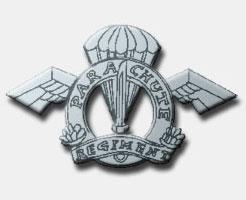
1961 saw the raising of the 4th battalion to augment the strength of the regiment. After the Sino-Indian War of 1962, the regiment, as with the rest of the armed forces, saw expansion on an unprecedented scale, with the 5th battalion raised in 1962, the 6th battalion raised in 1963 and the 7th battalion raised in 1964, followed by raising of the 8th battalion. A second parachute brigade, the 51st, was also raised to complement the 50th Brigade but was reverted to normal infantry role in 1976.
Of the original units of the 50th Parachute Brigade, only two exist as of date, namely 411 Parachute Field Company of the Bombay Sappers, the oldest parachute unit of the Indian Army and the 50th Parachute Brigade Signal Company. The original medical unit, 80 Parachute Field Ambulance, became part of 14 Parachute Brigade went over to Pakistan while 43 Para Field Ambulance was disbanded as with the other minor units of the 77th Para Brigade, and only one field ambulance, 60 Parachute Field Ambulance (now 60 Parachute Field Hospital) was retained in the airborne role. The other minor units followed suit. The Governor General’s Bodyguard was retained in the pathfinder role.
The first Indian airborne formation was the British Indian Army’s 50th Parachute Brigade raised on 29 October 1941, consisting of 151 Parachute Battalion (consisting of British troops), 152 Parachute Battalion (consisting of Indian troops) and 153 Parachute Battalion (consisting of Gurkha troops) alongside other support units.
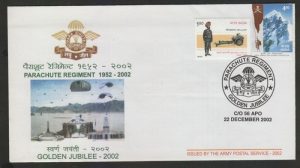
Lt. (later Col.) A.G. Rangaraj, MVC, of the Indian Medical Service and RMO of 152 Parachute Battalion, became the first Indian along with Hav. Maj. Mathura Singh to make a parachute descent. In 1942–43, the formation saw limited action at Nara against Pathan tribals in the North-West Frontier Province and conducted some intelligence-gathering missions in Burma, utilizing their somewhat limited airborne capabilities. In August 1943, the 154 Parachute Battalion was formed from troops from the 3rd battalion, 7th Gurkha Rifles and assigned to the 50th Parachute Brigade.[3] In March 1944, 151 Parachute Battalion was transferred to Britain, renamed as 156 Parachute Battalion, and assigned to the 4th Parachute Brigade of the 1st Airborne Division. The 50th Parachute Brigade, without 154 Parachute Battalion, then saw extensive action at Sangshak and later in the Imphal plains on the Burmese border against two reinforced Japanese divisions. 154 Parachute Battalion had not completed its air training, so stayed back to attain airborne status.
During the Battle of Sangshak (21–26 March 1944), which lasted six days, the brigade suffered extremely heavy casualties, totalling 40 officers and VCOs and 545 other ranks, winning the appreciation of Lt. Gen. William Slim, the commander of the British Fourteenth Army. The breakout on the night of 26 March 1944 saw the remnants of the once-proud parachute brigade fight its way south and then west through the Japanese-infested jungles to Imphal. It achieved its task of preventing the flanking Japanese forces from surrounding Imphal and destroying IV Corps. Despite the losses it suffered in Sangshak, the paratroopers formed ad hoc units and continued to participate in actions to destroy Japanese forces near and around Imphal until its withdrawal at the end of July.
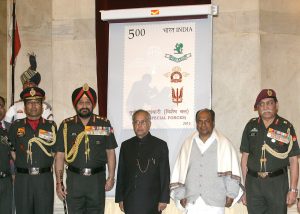
Later in 1944, the brigade was expanded to form the 44th Indian Airborne Division as the original 9th Airborne Division was to be named because the 44th Armoured Division (whose services were no longer required in the Middle East theatre of war) was to be converted to an airborne unit. The two ad hoc brigades from the Chindit operations, 14th and the 77th, were included to form the division. The original plan was to have a battalion each of British troops, Indian troops and Gurkha troops in both the parachute brigades, with the 14th being converted for the airlanding role, though there is little known about gliderborne training or operations in India. 14th was later to be converted for the airborne role. The Governor General’s Bodyguard (GGBG) joined the airborne fraternity and was named the 44th Airborne Division Reconnaissance Squadron. 9 Field Regiment (RIA) and other support units too were inducted. 60th Indian Parachute Field Ambulance which till then had been in Burma and performed well, was selected to augment the medical element for the formation. The 44th Indian Airborne Division was finally designated the 2nd Indian Airborne Division in 1945. The plan was to raise an entire airborne corps with the British 6th Airborne Division (of D-Day/Normandy fame) to be brought to India as the second divisional formation, but the war ended before it could materialize.
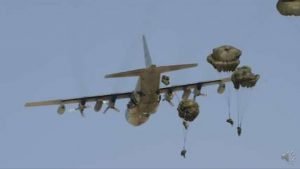
The Indian Army’s Parachute Regiment was officially formed on 1 March 1945, consisting of four battalions and an equal number of independent companies. The regiment’s first airborne action was towards the end of the war, when a reinforced Gurkha Parachute Battalion was parachuted into Burma at Elephant Point on 1 May 1945, as part of Operation Dracula. The battalion performed well earning the respect of all, including the critics of airborne warfare. Despite the performance in Operation Dracula, the Parachute Regiment was disbanded in late 1945 as part of the reduction and restructuring of the post-war British Indian Army. However, they retained their airborne role and formed part of the airborne division. Seven years later on 15th April 1952 the Parachute Regiment was reborn to become the bravest of the brave.
Content all from Wikipedia & open medium.






































